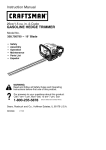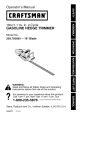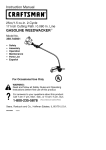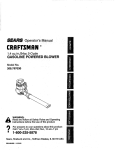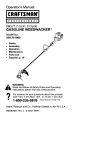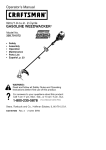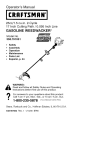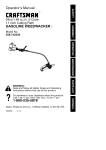Download Craftsman 358.795700 Operator`s manual
Transcript
Operator's Manual I CRRFTSMRN°I 19cc/1.2 cu. in. 2-Cycle GASOLINE HEDGE TRIMMER Model No. 358.795700 - 18" Blade WARNING: Read and follow all Safety Rules and Operating Instructions before first use of this product. For answers Call 7 am-7 to your questions about this product: pm, Mon-Sat; 10 am-7 pm, Sun 1-800-235-5878 Sears, 530086386 Roebuck 3/22/01 and Co., Hoffman (Hours listed are Central Time) Estates, IL 60179 U.S.A. Warranty Statement Safety Rules Assembly Operation Maintenance Service & Adjustments 2 2 4 5 7 8 Storage Troubleshooting Table Emissions Statement Parts List Spanish Parts and Ordering 10 11 11 13 16 Back Cover FULL ONE YEAR WARRANTY ON CRAFTSMAN ® GAS POWERED HEDGE TRIMMER For one (1) year from the date of purchase, when this Craftsman Gas Powered Hedge Trimmer is maintained, lubricated, and tuned up according to the operating and maintenance instructions in the operator's manual, Sears will repair, free of charge, any defects in materials or workmanship. This warranty excludes spark plug, air filter, and the blade which are expendable parts and may become worn during normal use. Ifthis Hedge Trimmer is used for commercial purposes, this warranty applies for only 90 days from the date of purchase. If this Hedge Trimmer is used for rental purposes, this warranty applies for only 30 days from the date of purchase. This warranty applies only while this product is used in the United States. WARRANTY SERVICE IS AVAILABLE BY RETURNING THE HEDGE TRIMMER TO THE NEAREST SEARS STORE OR SERVICE CENTER IN THE UNITED STATES. This warranty gives you specific legal rights, and you may also have other rights which vary from state to state. Sears, Roebuck and Co,, D/817WA, Hoffman Estates, IL 60179 PLAN AHEAD z't DANGER: THIS POWER TOOL CAN BE DANGEROUS! This unit can cause serious injury including amputation or blindness to the operator and others. The warnings and safety instructions in this manual must be followed to provide reasonable safety and efficiency in using this unit. The operator is responsible for following the warnings and instructions in this manual and on the unit. Never allow children to use this tool. ,_k WARNING: Failure to follow all Safety Rules and Precautions can result in serious injury. KNOW YOUR UNIT • Read your Operator's Manual carefully until you completely understand and can follow all warnings and safety rules before operating the unit. • Restrict unit to users who understand and will follow all warnings and safety rules in this manual and on the unit. WARNING: Inspect the area before starting the unit. Remove all debris and hard objects such as rocks, glass, wire, etc. that can ricochet, be thrown, or otherwise cause injury or damage during operation. • Always wear eye protection when operating, servicing, or performing maintenance on unit. Wearing eye protection will help to prevent brush or debris from being thrown or ricocheting into eyes and face which can result in blindness and/or serious injury. Eye protection should be marked Z87. • Wear hearing protection when using this unit. • Secure hair above shoulder length. Secure or remove jewelry, loose clothing, or clothing with loosely hanging straps, ties, tassels, etc. They can be caught in moving parts. • Stay alert. Do not operate unit when you are tired, ill, upset, or if you are under the influence of alcohol, drugs, or medication. Blades can throw objects violently. • You canbeblinded orinjured. • Wear safety glasses. Glasses Boots HAZARD ZONE _ .............. _ %_:d & WARNING: Hazard zone forthrown objects • Blades can throw objects violently. • Others canbeblinded orinjured, • Keep people and animals 30feet (10m)away. Blades move Allow blades to stop _ Ot_entarily before removing _ after the them from the cut. trigger is • Keep children, bystanders, and animals away from work area a minimum of 30 feet (10 m) when starting or operating unit. If situations occur which are not covered in this manual, use care and good judgment. If you need assistance, contact your Sears Service Center or call the Customer Assistance Helpline at 1-800-235-5878. HANDLE FUEL WITH CAUTION • Eliminate all sources of sparks or flame (including smoking, open flames, or work that can cause sparks) in the areas where fuel is mixed, poured, or stored. • Mix and pour fuel in an outdoor area; store fuel in a cool, dry, well ventilated place; use an approved, marked container for all fuel purposes. • Do not smoke while handling fuel or while operating the unit. • Do not fill fuel tank while engine is running. • Make sure the unit is properly assembled and in good operating condition. • Avoid spilling fuel or oil. Wipe up fuel spills before starting the engine. • Move at least 10 feet (3 meters) away from fuel and fueling site before starting engine. • Always store gasoline in a container approved for flammable liquids. WARNI NG: Blades move momentarily after the trigger is released. • The blades can seriously cut you or others. • Allow blades to stop before removing them from the cut. OPERATE YOUR UNIT SAFELY DANGER: RISK OF CUT; KEEP HANDS AWAY FROM BLADE - Blade moves momentarily after the trigger is released. Do not attempt to clear away cut material when the blade is in motion. Make sure the switch is in the OFF position, the spark plug wire is disconnected, and the blade has stopped moving before removing jammed material from the cutting blade. Do not grab or hold the unit by the cutting blade. • Inspect unit before each use for worn, loose, missing, or damaged parts. Do not use until unit is in proper working order. • Keep outside surfaces free from oil and fuel. • Never start or run engine inside a closed room or building. Breathing exhaust fumes can kill. • Avoid dangerous environments. Do not use in unventilated areas or where explosive vapors or carbon monoxide build up could be present. • Do not overreach or use from unstable surfaces such as ladders, trees, steep slopes, rooftops, etc. Keep firm footing and balance at all times. • Do not raise unit above your shoulders; the cutting blade can come dangerously close to your body. • Always keep unit in front of your body. Keep all parts of your body away from the cutting blade. • Keep thecutting blade andairvents SAFETY NOTICE: Exposure tovibrafreefromdebris. tionsthrough prolonged useofgaso• Useonlyforjobsexplained inthis linepowered hand toolscouldcause manual. blood vessel ornerve damage inthe MAINTAIN YOUR UNITPROPERLYfingers, hands, andjoints ofpeople • Have allmaintenance andservice prone tocirculation disorders orabnormalswelling. Prolonged useincold notexplained inthismanual perhasbeenlinked toblood vesformed byaSears Service Center. weather inotherwise healthy • Disconnect spark plugbefore per- seldamage Ifsymptoms occur suchas forming maintenance except forcar- people. numbness, pain, lossofstrength, buretor adjustments. • Donotuseacutting blade thatis change inskincolor ortexture, orloss offeeling inthefingers, hands, or bent, warped, cracked, broken, or joints, discontinue theuseofthistool damaged inanyother way.Have attention. An worn ordamaged partsreplaced by andseekmedical antivibration system doesnotguaranyourSears Service Center. ofthese problems. • Useonlyrecommended Craftsman teetheavoidance cutting blades andreplacement Users whooperate power toolsona continual andregular basis mustmoniparts; useofanyother partsmay theirphysical condition and voidyourwarranty andcause dam- torclosely thecondition ofthistool. agetoyourunit. • Empty fueltankbefore storing theunit. SPECIAL NOTICE: Your hedge trimUseupfuelleftincarburetor bystartingmerisequipped withatemperature engine andletting itrununtilitstops. limiting muffler andspark arresting • Hand carrytheunitwiththeengine screen which meets therequirements Codes 4442and4443.All stopped andthemuffler andcutting ofCalifornia U.S. forest landandthestates ofCaliblade away fromyourbody. Idaho, Maine, Minnesota, New • Allow engine tocool,empty thefuel fornia, tank, andsecure theunitbefore stor- Jersey, Oregon, andWashington reinternal comingortransporting itinavehicle. quirebylawthatmany • Donotstore theunitorfuelina bustion engines beequipped witha closed areawhere fuelvapors can spark arresting screen. Ifyouoperate trimmer inastateorlocale reach sparks oranopenflame from ahedge hotwater heaters, electric motors or where suchregulations exist, youare switches, furnaces, etc. legally responsible formaintaining the condition ofthese parts. • Store theunitsothecutting blade operating Failure todosoisaviolation ofthelaw. cannot accidentally cause injury. Fornormal homeowner use,themuffler • Store inadryareaoutofreach of children. andspark arresting screen willnotrequireanyservice. After50hours of use,werecommend thatyourmuffler beserviced orreplaced byyourSears Service Center. CARTON CONTENTS Check carton contents against thefollowing list. Model 358,795700 • Hedge Trimmer • 2-Cycle Engine Oil NOTE: Itisnormal forthefuelfilterto rattleintheempty fueltank. ASSEMBLY Yourhedge trimmer isfullyassembled; noassembly isrequired. KNOW YOUR HEDGE TRIMMER READ THIS OPERATOR'S MANUAL AND SAFETY RULES BEFORE OPERATING YOUR UNIT. Compare theillustrations withyourunittofamiliarize yourself withthelocation of the various controls and adjustments. ence. ON/OFF Switch _ -- Choke .,v ......... ....... Spark Plug Primer Bulb __ T h rottl e Trigger !.___ "_--._/_._ .... 7-_:_',,__.. Starter Rope "., --P_j_-'_.*-4_,,. Muffler ON/OFF SWITCH The ON/OFF SWITCH is used to stop the engine. To stop the engine, move the switch to the OFF position. CHOKE The CHOKE helps to supply fuel to the engine to aid in cold starting. Activate the choke by moving choke lever to the desired position. See STARTING YOUR ENGINE for complete starting information. BEFORE STARTING ,_L WARNING: Save this manual for future refer- ENGINE Be sure to read the fuel information in the safety rules before you begin. If you do not understand the safety rules, do not attempt to fuel your unit. Call 1-800-235-5878. FUELING ENGINE This engine is certified to operate on unleaded gasoline. Before operation, gasoline must be mixed with a good quality 2-cycle air-cooled engine oil. We recommend Craftsman brand oil. Mix gasoline and oil at a ratio of 40:1 (A 40:1 ratio is obtained by mixing 3.2 ounces of oil with 1 gallon of unleaded gasoline). DO NOT USE automotive oil or boat oil. These oils will cause engine damage. When mixing fuel, follow instructions printed on the oil container. Once oil is added to gasoline, shake container momentarily to assure that the fuel is thoroughly mixed. Always read and follow the safety rules relating to fuel before fueling your unit. _o ""_ PRIMER BULB The PRIMER BULB removes air from the fuel lines and fills them with fuel. This allows you to start the engine with fewer pulls on the starter rope. Activate the primer bulb by pressing it and allowing it to return to its original form. THROTTLE TRIGGER The THRO-FILE TRIGGER controls engine speed. Squeeze the trigger for full speed operation; release it for idle speed. IMPORTANT Experience indicates that alcohol blended fuels (called gasohol or using ethanol or methanol) can attract moisture which leads to separation and formation of acids during storage. Acidic gas can damage the fuel system of an engine while in storage. To avoid engine problems, empty the fuel system before storage for 30 days or longer. Drain the gas tank, start the engine and let it run until the fuel lines and carburetor are empty. Use fresh fuel next season. Never use engine or carburetor cleaner products in the fuel tank or permanent damage may occur. See the STORAGE section for additional information. OPERATING POSITION ON OFF ...... Switch _ Eye Protection € t_LX, k._/ 3. Slowly press the primer bulb 6 times. 4. Move the choke lever to the FULL STOPPING YOUR ENGINE • To stop the engine, move the ON/OFF switch to the OFF position. BEFORE STARTING THE ENGINE • Fuel engine. Move at least 10 feet (3 meters) away from the fueling site. • Hold the unit on the ground in the starting position as shown. Support unit so the blade is off of the ground and away from trees, bushes, onlookers, etc. CHOKE position. Choke Primer STARTING A COLD ENGINE (or a warm engine after running out of fuel) Throttle f Lock Throttle _ Lock-out Throttle Trigger 1. Move the ON/OFF switch to the ON position. 2. Engage the throttle lock as follows: • press the throttle lock-out; • squeeze and hold throttle trigger; • press and hold throttle lock; • release the throttle trigger Keep the throttle lock engaged until the engine runs smoothly. -6- Bulb 5. Pull starter rope handle sharply until engine sounds as if it is trying to start, but do not pull rope more than 6 times. 6. As soon as engine sounds as if it is trying to start, move the choke lever to HALF CHOKE position. 7. Pull starter rope sharply until the engine runs, but no more than 6 pulls. NOTE: If the engine doesn't start after 6 pulls (at the HALF CHOKE position), check to make sure the ON/ OFF switch is in the ON position. Move the choke lever to the FULL CHOKE position and press the primer bulb 6 times; pull the starter rope 2 more times. Move the choke lever to the HALF CHOKE position and pull the starter rope until the engine runs, but no more than 6 more pulls. If the engine still doesn't start, it is probably flooded. Proceed to STARTING A FLOODED ENGINE. 8. Once the engine starts, allow it to run 10 seconds, then move the choke lever to the OFF CHOKE position. Allow the unit to run for 30 more seconds at the OFF CHOKE position before squeezing and releasing the throttle trigger to release the throttle lock. NOTE: If engine dies with the choke lever in the OFF CHOKE posi- tion, move the choke lever to the HALF CHOKE position and pull the rope until engine runs, but no more than 6 pulls. STARTING A WARM ENGINE 1. Move the ON/OFF switch to the ON position. 2. Move the choke lever to the HALF CHOKE position. 3. Engage the throttle lock as directed in STARTING A COLD ENGINE. Keep the throttle lock engaged until the engine runs smoothly. 4. Pull starter rope sharply until engine runs, but no more than 5 pulls. 5. Allow the engine to run 10 seconds, then move choke lever to the OFF CHOKE position. CUSTOMER 6. Release the throttle lock by squeezing and releasing the throttle trigger. NOTE: If engine has not started, pull starter rope 5 more pulls. If engine still does not run, it is probably flooded. Proceed to STARTING A FLOODED ENGINE. STARTING A FLOODED ENGINE Flooded engines can be started by placing the switch in the ON position and the choke lever in the OFF CHOKE position; then, pull the rope to clear the engine of excess fuel. Starting could require pulling the starter rope many times depending on how badly the unit is flooded. If the unit still doesn't start, refer to the TROUBLESHOOTING TABLE or call 1-800-235-5878. RESPONSIBILITIES WARNING: Disconnect the spark plug before performing except for carburetor adjustments. CARE & MAINTENANCE TASK Check for loose fasteners and parts Check for damaged WHEN TO PERFORM Before each use Before each use or worn parts After each use Inspect and clean unit and labels Clean air filter Inspect muffler and spark arresting Replace Every 5 hours of operation screen spark plug Replace fuel filter GENERAL RECOMMENDATIONS The warranty on this unit does not cover items that have been subjected to operator abuse or negligence. To receive full value from the warranty, the operator must maintain unit as instructed in this manual. Various adjustments will need to be made periodically to properly maintain your unit. CHECK FOR LOOSE FASTENERS AND PARTS • Spark Plug Boot • Air Filter • Housing Screws Every 50 hours of operation Yearly Yearly sure engine stops; then restart engine and continue. • Fuel Tank - Do not use unit if fuel tank shows signs of damage or leaks. INSPECT AND CLEAN UNIT AND LABELS • After each use, inspect complete unit for loose or damaged parts. Clean the unit and labels using a damp cloth with a mild detergent. • Wipe off unit with a clean dry cloth. CLEAN AIR FILTER Air Filter CHECK FOR DAMAGED OR WORN PARTS Contact Sears Service Center for replacement of damaged or worn parts. • ON/OFF Switch - Ensure ON/OFF switch functions properly by moving the switch to the OFF position. Make maintenance jJ Air Filter Cover Screws Adirtyairfilterdecreases engine per- 2.Remove spark plugfromcylinder formance andincreases fuelconsump- anddiscard. tionandharmful emissions. Always 3.Replace withChampion RCJ-8Y clean afterevery 5hours ofoperation. spark plugandtighten witha3/4in. 1.Clean thecover andthearea socket wrench (10-12 ft.-Ibs). around ittokeepdebris fromfalling 4.Reinstall thespark plugboot. intothecarburetor chamber when REPLACE FUEL FILTER thecover isremoved. Toreplace fuelfilter, drainunitbyrun2.Remove parts asillustrated. ningitdryoffuel,thenremove fuelcap/ NOTE: Toavoid creating afirehazard retainer assembly fromtank.Pullfilter orproducing harmful evaporative emis- fromtankandremove itfromthefuel sions, donotclean filteringasoline or line.Install newfuelfilteronfuelline; other flammable solvent. reinstall parts. 3.Wash thefilterinsoap andwater. Fuel Filter 4.Allow filtertodry. 5.Addafewdrops ofoiltothefilter; squeeze filtertodistribute oil. 6.Replace parts. REPLACE SPARK PLUG Replace spark plugeachyeartoenFuel Line suretheengine starts easier andruns better. Setspark pluggapat0.025 in. Ignition timing isfixed, nonadjustable. 1.Twist, thenpulloffspark plugboot. We recommend all service and adjustments not listed in this manual be performed by your Sears Service Center. CARBURETOR ,_L WARNING: ADJUSTMENT The blade will be moving during most of this procedure. Wear your protective equipment and observe all safety precautions. After making mixture adjustments, recheck idle speed. The blade must not move at idle speed. Carburetor adjustment is critical and if done improperly can permanently damage the engine as well as the carburetor. If you require further assistance or are unsure about performing this procedure, call our customer assistance help line at 1-800-235-5878. Old fuel, a dirty air filter, a dirty fuel filter, or flooding may give the impression of an improperly adjusted carburetor. Check these conditions before adjusting the carburetor. The carburetor has been carefully set at the factory. Adjustments may be necessary if you notice any of the following conditions: • The blade moves at idle. See IDLE SPEED under adjusting procedure. • Engine will not idle. See IDLE SPEED under adjusting procedure. -8- • Engine dies or hesitates instead of accelerating. See ACCELERATION CHECK under adjusting procedure. • Loss of power. See MIXTURE ADJUSTMENT (L or H) under adjusting procedure. There are three adjustment screws on the carburetor. The low speed adjustment screw is marked with the letter L, and the high speed screw is marked with the letter H. The third screw is the idle speed screw. Low Speed Screw \ Idle Speed Screw H High Speed Screw 2, L Screws with (¢£_)00L_)"_'_ Limiter Caps ADJUSTING PROCEDURE CAUTION: Do not force plastic limiter caps on screws beyond the built-in stops or damage will occur. Initial Settings 1. Turn both mixture screws (L and H) counterclockwise until they stop. 2. Turn the idle speed screw clockwise until it stops. Now turn counterclockwise 4-1/2 turns. 3. Start engine and let it run for 3 minutes, then proceed to adjust screws according to the instructions below. If engine performance at initial settings is acceptable, no further adjustments are necessary. If engine does not start, refer to the TROUBLESHOOTING TABLE. If still unable to remedy situation, call 1-800-235-5878. Idle Speed Allow engine to idle. If the blade moves, idle speed is too fast. If the engine stalls, idle speed is too slow. • Turn idle speed screw clockwise to increase engine speed. • Turn idle speed screw counterclockwise to decrease engine speed. _WARNING: Recheck the idle speed after each adjustment. The blade must not move at idle speed to avoid serious injury to the operator and others. Low Speed Mixture - L 1. Allow the engine to idle. 2. Turn low speed mixture screw (L) slowly clockwise until the speed starts to drop. 3. Turn the low speed mixture screw (L) counterclockwise until the speed increases and then starts to drop again. 4. Set the low speed mixture screw (L) at the midpoint between the two positions. Readjust the idle speed (see IDLE SPEED). -9- High Speed Mixture - H CAUTION: Do not operate engine at full throttle for prolonged periods while making high speed adjustments as damage to the engine can occur. Adjust the high speed screw 1/16 of a turn at a time. A 1/16 turn is about the width of the slot in the top of the screw. 1. Allow the engine to idle. 2. Squeeze the throttle trigger fully. Turn the high speed mixture screw (H) counterclockwise until it stops. 3. Turn the high speed mixture screw (H) screw the minimum amount clockwise until the engine runs smoothly. After completing adjustments, check for acceleration and blade movement at idle. Reset if necessary. Acceleration Check If the engine dies or hesitates instead of accelerating, turn the low speed mixture screw (L) counterclockwise until you have smooth acceleration with no blade movement at idle. CAUTION: If the engine does not operate according to these instructions after repeating the adjusting steps, do no use the unit. Take it to your Sears Service Center. ,_ WARNING: Perform the following steps after each use: • Allow engine to cool, and secure the unit before storing or transporting. • Store unit and fuel in a well ventilated area where fuel vapors cannot reach sparks or open flames from water heaters, electric motors or switches, furnaces, etc. • Store unit with all guards in place. Position unit so that any sharp object cannot accidentally cause injury. • Store unit and fuel well out of the reach of children. SEASONAL STORAGE Prepare unit for storage at end of season or if it will not be used for 30 days or more. If your unit is to be stored for a period of time: • Clean the entire unit before lengthy storage. • Store in a clean dry area. • Lightly oil external metal surfaces, including the blade. To oil the blade: • Stop the engine and allow blade to come to a complete stop. • Disconnect the spark plug wire. • Clean all parts and check for damage. Have damaged parts repaired or replaced by your Sears Service Center. • Apply a light machine oil along the edge of the top strap as shown. -10- FUEL SYSTEM Under FUELING ENGINE in the OPERATION section of this manual, see message labeled IMPORTANT regarding the use of gasohol in your engine. Fuel stabilizer is an acceptable alternative in minimizing the formation of fuel gum deposits during storage. Add stabilizer to gasoline in fuel tank or fuel storage container. Follow the mix instructions found on stabilizer container. Run engine at least 5 minutes after adding stabilizer. Craftsman 40:1,2-cycle engine oil (air cooled) is already blended with fuel stabilizer. If you do not use this Sears oil, you can add a fuel stabilizer to your fuel tank. ENGINE • Remove spark plug and pour 1 teaspoon of 40:1,2-cycle engine oil (air cooled) through the spark plug opening. Slowly pull the starter rope 8 to 10 times to distribute oil. • Replace spark plug with new one of recommended type and heat range. • Clean air filter. • Check entire unit for loose screws, nuts, and bolts. Replace any damaged, broken, or worn parts. • At the beginning of the next season, use only fresh fuel having the proper gasoline to oil ratio. OTHER • Do not store gasoline from one season to another. • Replace your gasoline can if it starts to rust. TROUBLESHOOTING TABLE WARNING: Always stop unit and disconnect spark plug before performing all of the recommended remedies below except remedies that require operation of the unit. REMEDY TROUBLE CAUSE Engine will not start. 1. ON/OFF switch position, 2. Engine flooded, in the OFF 1. Move ON/OFF switch to the ON position. 2. See "Starting a Flooded Engine" in Operation Section. 3. Fill tank with correct fuel mixture. 4. Install new spark plug. 5. Check for dirty fuel filter; replace. Check for kinked or split fuel line; repair or replace. 6. Contact Sears Service Center. 3. Fuel tank empty. 4. Spark plug not firing. 5. Fuel not reaching carburetor. 6. Compression low. Engine will not idle properly. 1. Carburetor requires adjustment. 2. Crankshaft seals worn. 3. Compression low. 1. See "Carburetor Adjustment" in Service and Adjustments Section. 2. Contact Sears Service Center. 3. Contact Sears Service Center. Engine will not accelerate, lacks power, or dies under a load. 1. Air filter dirty. 2. Spark plug fouled. 1. Clean or replace air filter. 2. Clean or replace plug and regap. 3. See "Carburetor Adjustment" in Service and Adjustments Section. 4. Contact Sears Service Center. Engine smokes excessively. 3. Carburetor requires adjustment. 4. Carbon build-up on muffler outlet screen. 5. Compression low. 5. Contact 1. Fuel mixture Center. 1. Adjust choke. 2. Empty fuel tank and refill with correct fuel mixture. 3. Clean or replace air filter. 4. See "Carburetor Adjustment" in Service and Adjustments Section. 1. Choke partially on. 2. Fuel mixture incorrect. 3. Air filter dirty. 4. Carburetor requires adjustment. Engine runs hot. Sears Service incorrect. 1. See "Fueling Engine" in Operation section. 2. Replace with correct spark plug. 3. See "Carburetor Adjustment" in Service and Adjustments Section. 4. Contact Sears Service Center. 2. Spark plug incorrect. 3. Carburetor requires adjustment. 4. Carbon build-up on muffler outlet screen. If situations occur which are not covered in this manual, use care and good judgment. If you need assistance, contact your Sears Service Center or call the Customer Assistance Helpline at 1-800-235-5878. YOUR WARRANTY RIGHTS AND OBLIGATIONS: The U. S. Environmental Protection Agency and Sears, Roebuck and Co., U.S.A., are pleased to explain the emissions control system warranty on your lawn and garden equipment engine. All new utility and lawn and garden equipment engines must be designed, built, and equipped to meet the stringent anti-smog standards. Sears must warrant the emission control system on your lawn and garden equipment engine for -11 the periods of time listed below provided there has been no abuse, neglect, or improper maintenance of your lawn and garden equipment engine. Your emission control system includes parts such as the carburetor and the ignition system. Where a warrantable condition exits, Sears will repair your lawn and garden equipment engine at no cost to you. Expenses covered under warranty include diagnosis, parts and labor. MANUFACTURER'S WARRANTY COVERAGE: If - any emissions related part on your engine (as listed under Emissions Control Warranty Parts List) is defective or a defect in the materials or workmanship of the engine causes the failure of such an emission related part, the part will be repaired or replaced by Sears. OWNER'S WARRANTY RESPONSIBILITIES: As the lawn and garden equipment engine owner, you are responsible for the performance of the required maintenance listed in your Owner's Manual. Sears recommends that you retain all receipts covering maintenance on your lawn and garden equipment engine, but Sears cannot deny warranty solely for the lack of receipts or for your failure to ensure the performance of all scheduled maintenance. As the lawn and garden equipment engine owner, you should be aware that Sears may deny you warranty coverage if your lawn and garden equipment engine or a part of it has failed due to abuse, neglect, improper maintenance, unapproved modifications, or the use of parts not made or approved by the original equipment manufacturer. You are responsible for presenting your lawn and garden equipment engine to a Sears authorized repair center as soon as a problem exists. Warranty repairs should be completed in a reasonable amount of time, not to exceed 30 days. If you have any questions regarding your warranty rights and responsibilities, you should contact your nearest authorized service center or call Sears at 1-800-473-7247 WARRANTY COMMENCEMENT DATE: The warranty period begins on the date the lawn and garden equipment engine is purchased. LENGTH OF COVERAGE: This warranty shall be for a period of two years from the initial date of purchase. WHAT IS COVERED: REPAIR OR REPLACEMENT OF PARTS, Repair or replacement of any warranted part will be performed at no charge to the owner at an approved Sears servicing center. If you have any questions regarding your warranty rights and responsibilities, you should contact your nearest authorized service center or call Sears at -12- 1-800-473-7247. WARRANTY PERIOD: Any warranted part which is not scheduled for replacement as required maintenance, or which is scheduled only for regular inspection to the effect of "repair or replace as necessary" shall be warranted for 2 years. Any warranted part which is scheduled for replacement as required maintenance shall be warranted for the period of time up to the first scheduled replacement point for that part. DIAGNOSIS: The owner shall not be charged for diagnostic labor which leads to the determination that a warranted part is defective if the diagnostic work is performed at an approved Sears servicing center. CONSEQUENTIAL DAMAGES: Sears may be liable for damages to other engine components caused by the failure of a warranted part still under warranty. WHAT IS NOT COVERED: All failures caused by abuse, neglect, or improper maintenance are not covered. ADD-ON OR MODIFIED PARTS: The use of add-on or modified parts can be grounds for disallowing a warranty claim. Sears is not liable to cover failures of warranted parts caused by the use of add-on or modified parts. HOW TO FILE A CLAIM: If you have any questions regarding your warranty rights and responsibilities, you should contact your nearest authorized service center or call Sears at 1-800-473-7247. WHERE TO GET WARRANTY SERVICE: Warranty services or repairs shall be provided at all Sears service centers. call: 1-800-473-7247. MAINTENANCE, REPLACEMENT AND REPAIR OF EMISSION RELATED PARTS: Any Sears approved replacement part used in the performance of any warranty maintenance or repair on emission related parts will be provided without charge to the owner if the part is under warranty. EMISSION CONTROL WARRANTY PARTS LIST: Carburetor, Ignition System: Spark Plug (covered up to maintenance schedule), Ignition Module. MAINTENANCE STATEMENT: The owner is responsible for the performance of all required maintenance as defined in the owner's manual.












